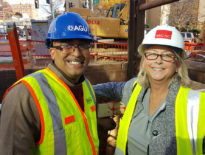
Brad Liljequist: Hi David—tell us about yourself.
David Mead: I’m a Building Performance Specialist at PAE Engineers. I work as both an energy engineer and architect within our office, integrating systems to achieve high performance goals for projects. I went to school for architecture originally, and I kept wanting to focus on performance, and realized building systems were the key to improve performance. I’m functionally a mechanical/energy engineer on a daily basis now, making sure all the pieces are integrated.
BL: A very important role indeed! So you were a Project Drawdown Fellow—what is Project Drawdown?
DM: Project Drawdown was created by Paul Hawken. I understand he created it after reading the seminal article several years ago in Rolling Stone by Bill McKibben, addressing just how challenging the climate change numbers are looking.
Paul was concerned that the sustainability movement had a strong doomsday narrative, and that the language people were using was self-defeating. The whole idea of Project Drawdown was to say, “Okay. Let’s look at the solutions,” because everybody had been looking at what the problems were. He also wanted a holistic look at what solutions could be. He put a call out to researchers all over the world, to see if people would be interested in helping with this—and they got an amazing response.
BL: It’s interesting how influential Paul Hawken has been for so many of us at different points along the last couple decades. He’s a very important person in our movement. So how and why did you get involved in Project Drawdown?
DM: I saw an online post about Project Drawdown. I read the premise and thought it was brilliant, because of its solutions focus. It matched what we do in our industry, and what I do on a daily basis. I personally know there are a ton of solutions, and that we can effectively address climate change. So I offered for PAE Engineering to be advisors on the project, which we did, and then a few months later, I actually got an email from Paul, asking if I would be interested in doing the Net Zero buildings fellowship.
BL: Project Drawdown identified about 100 tangible climate solutions—what were some of the most compelling things that you learned being part of it?
DM: Within the realm of normalizing zero energy buildings, it’s clear that we are just at the very beginning of its growth—it’s behind the overall market uptake of solar energy generally. But the critical thing we learned was that if you look at the numbers, it is clear that zero energy has to target existing buildings and retrofits—we simply won’t reach our numbers if we don’t.
BL: I totally agree. I was at the American Geophysical Union building in Washington, DC, a couple weeks ago, an existing five-story building that they are retrofitting to be zero energy. They’re doing it in a cost-effective, thoughtful, pragmatic way. We have to take advantage of major renovations as they happen.
DM: Right. Another big surprise was the refrigerant management impacts—refrigerants have a high global warming potential and the majority leak into the atmosphere out of HVAC equipment and appliances. I’ve always known that’s an issue, and we have talked about it within our firm quite a bit. But to see it be the number one solution in Project Drawdown is really concerning. In some cases, it can completely offset whatever emissions savings you’ll have from energy efficiency.
BL: It’s a huge issue, and we’ve been talking about it a lot too at the Institute. I think that we want to tackle this as soon as we can. The revisions to the Montreal protocol were great, but they’re also slow. So what are the alternatives?
DM: One is to take a super passive, envelope driven approach using electric resistance. The Rocky Mountain Institute Innovation Center took this approach in climate zone seven, which is unheard of.
BL: It’s amazing.
DM: Yeah, it’s so cold there. But that approach works best in cold, sunny climates—it’s harder in humid climates.
There are also natural refrigerants, that been used since the 19th century actually—CO2 and ammonia—and these are coming to be used more again. The problem is that they both have engineering challenges. CO2 is good for heating, not very good for cooling, and ammonia has its own challenges.
There are also natural refrigerants, that been used since the 19th century actually—CO2 and ammonia—and these are coming to be used more again. The problem is that they both have engineering challenges. CO2 is good for heating, not very good for cooling, and ammonia has its own challenges.
BL: The CO2 heat pumps have a temperature range that is challenging in some cases, right? But also very advantageous in others. I’ve been super impressed by the Sanden CO2 heat pumps, as well as the larger ones by Mayekawa and others.
DM: There are new refrigerants coming out known as A2L refrigerants, but they’re mildly flammable. This is a potential issue if it’s being pumped around a building with refrigerant lines, like in a split or VRF system. So we’ll see where that lands but it is likely most of the market will move to those newer refrigerants.
BL: You were talking a little bit about where we are in the growth trajectory with zero energy. What we see is that the growth of zero energy buildings is exponential—not aggressively so, but the trend is real. In the last couple of months, we’ve averaged nearly three projects registering a week, during what is normally a quiet time of the year—certainly the fastest rate we’ve ever seen.
DM: That’s great.
BL: So what do you think it’s going to take to make zero energy the new normal?
DM: I think a lot of society doesn’t know it’s possible. It’s not part of our cultural narrative. We have to show the broader culture that we can truly address climate change. We just need more examples, both at the high end and in everyday vernacular architecture, in more locations. And then we need to be sure people know about them—many people in Seattle still don’t know about the Bullitt Center.
I think the other thing is getting serious about putting financial resources into the solutions. If you took the top ten Project Drawdown solutions, it seems quite prohibitive, like billions and billions of dollars. But from a societal standpoint, it seems easy. I wondered if you just took the hundred richest people in the world and you just looked at how much they’re worth. Could they actually implement these solutions? The answer, at a high level, is yes—a hundred people have more than enough money to pay for the top ten solutions which would help 7.6 billion people. We live in unusual times, right? Wealth is so concentrated.
BL: Just to put another cut on it… something I talked about in The Power of Zero is that the United States spent 7.2 trillion dollars in military spending in the Middle East since the 70’s—that equals $59,000 dollars per American household. Which ironically is about the same cost it would be to retrofit every house in the US to be zero energy. Whether it’s coming from above or below, it feels like we can do it, but it is going to have to be that scale of intervention too.
DM: Yep.
BL: If you got to be king for a day or Bill Gates, what would you do to make zero energy buildings the norm?
DM: I think, I would challenge all the leaders of the world to start talking about solutions and stop focusing on short-term profits. Like short-term, even in your own lifetime. I always like ideas such as we’re borrowing this planet from our grandchildren. Also, there’s the carrot versus the stick. We’ve incentivized elements of zero energy, and the adoption rate tends to be really small. Whereas, if it’s code, the adoption rate tends to be a lot higher—pretty much 100%.
BL: My philosophy is that you use incentives and inspiration and all those things to get to a couple percent of the market adoption zero energy. Enough that you get your examples, you get your inspiration, you get your knowledge base going, and then it needs to be codified. Given the scale of the problem right now, it seems like that’s what we have to do.
DM: It is sad to me the narrative around climate has become so entrenched and politicized. We need a better dialogue and better solutions to try to get everybody onboard. I think Project Drawdown is a great example of that, where it gets people across lots of spectrums to see that there are solutions. It’s not a political debate; it’s based on science and physics.
BL: It’s really about risk management at the end of the day.
DM: Another area that was highlighted in Drawdown was food production. That is actually where they saw the most emission savings—there is so much waste in food production, which is really fascinating. Growing food in your yard, limited meat consumption, using ugly produce, are all very important. Everybody who reads this should go plant a garden and try to grow as much food as they can in their yard. Try to be as resilient and self-sufficient as possible. And a lot of that fits in the conservative, self-sufficient approach.
BL: Any final thoughts?
DM: I’m still hopeful, and I think that’s the key takeaway of Drawdown. Stay focused on the solutions—let’s get this done!


